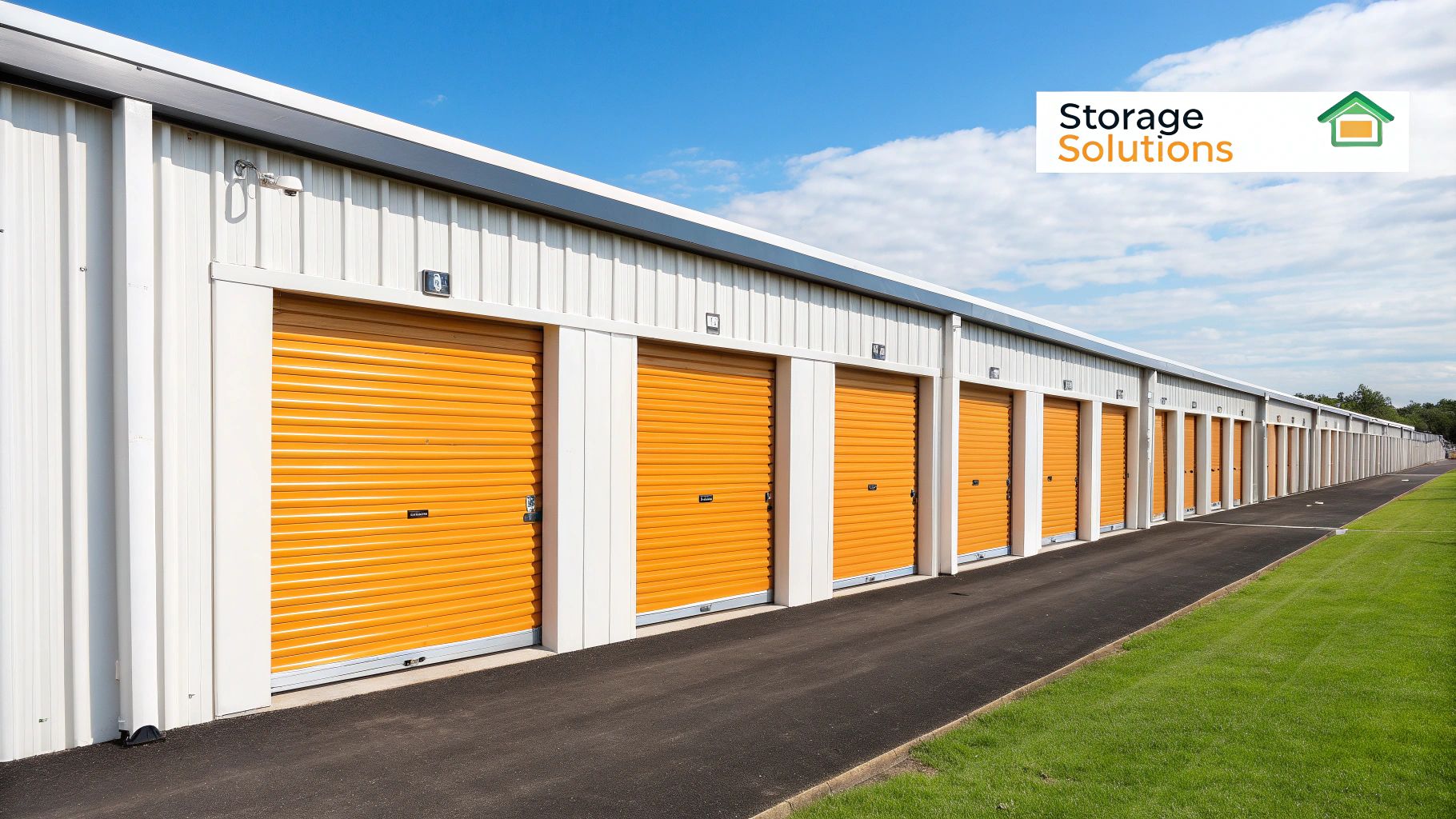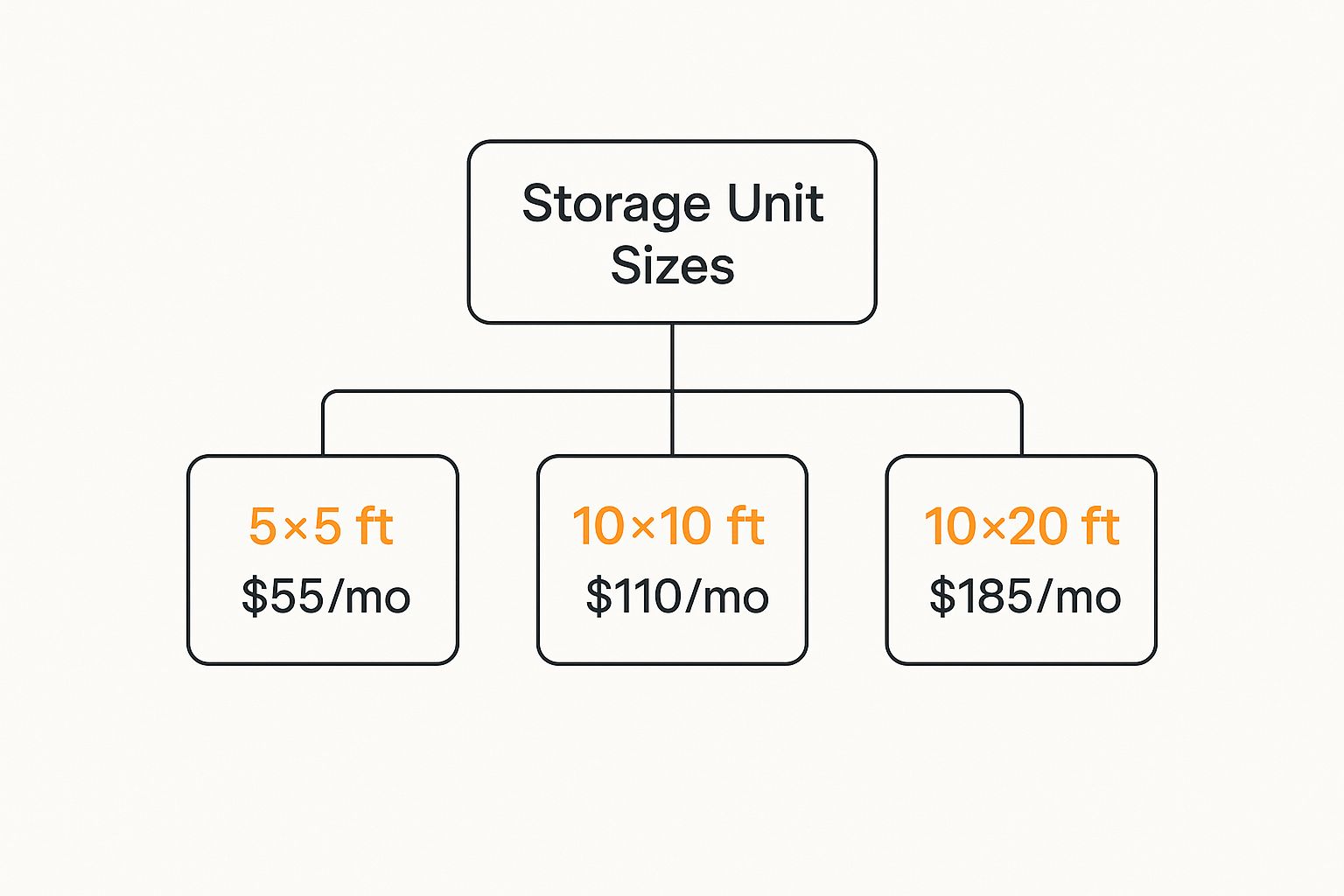So, you're wondering what it costs to rent a storage unit in the UK. The short answer is it can range from £15 per week for a small unit to over £65 per week for a large one. But honestly, the final price really hinges on the size you need, where you are in the country, and any extra features you might want.
Your Quick Guide to UK Storage Unit Prices
Trying to pin down a single price for self-storage can feel like hitting a moving target. The truth is, there’s no fixed price tag that applies everywhere in the UK. It’s a bit like booking a hotel room—the cost shifts depending on the city, the size of the room, and even the time of year.
Several key factors come into play, and understanding them is the first step to finding a unit that fits your budget without any nasty surprises. The big three that really drive the average price of a storage unit are:
- Geographic Location: No surprise here. A unit in central London will almost always cost more than an identical one in a smaller town, simply because of higher property values.
- Unit Size: This one's straightforward. The more space you need, the higher the weekly or monthly fee.
- Special Features: Extras like climate control, 24/7 access, or enhanced security will naturally add a bit more to the base price.
Once you’ve got your head around these variables, you’ll be in a much better position to start your search. After you have a clearer idea of the cost, you can find out more about how to rent a storage unit to make the whole process a breeze.
Average UK Storage Unit Prices at a Glance
To give you a clearer picture, we've put together a quick summary of what you can typically expect to pay. This table breaks down common unit sizes, what they can generally hold, and the average weekly and monthly prices across the UK.
Think of this as your starting point for budgeting.
| Unit Size (sq ft) | Typical Use | Average Weekly Cost | Average Monthly Cost |
|---|---|---|---|
| 25-35 sq ft | Contents of a studio flat or garden shed | £15 – £25 | £60 – £100 |
| 50-75 sq ft | Contents of a 1-2 bedroom flat | £25 – £45 | £100 – £180 |
| 100-150 sq ft | Contents of a 2-3 bedroom house | £45 – £65+ | £180 – £260+ |
Remember, these are just averages. Your final quote will depend on the specific facility and the factors we mentioned earlier, but this should help you get a solid idea of what to expect.
Why Location Dictates Your Storage Costs
Ever noticed how a flat white in central London costs a fair bit more than one in a small town? The very same logic applies to self-storage. In fact, geography is probably the single biggest factor that will shape the final price you pay. Getting your head around this regional difference is the first step to finding the best value.
A storage unit isn't just empty space; you're essentially renting a tiny piece of real estate. Facilities plonked in major urban centres have to deal with higher land costs, business rates, and general running expenses. Those costs inevitably get passed on to you, which is why the average price of a storage unit can swing so wildly from one postcode to the next.
Urban Premiums Versus Rural Savings
In packed cities like London, Manchester, or Birmingham, the demand for storage is through the roof. Space is at a premium, and with more people living in smaller flats and apartments, the need for extra room is constant. This intense demand, combined with eye-watering commercial property prices, fires up a competitive market where prices naturally climb.
On the flip side, facilities in more rural or suburban spots have much lower overheads. Land is cheaper, and there's often less competition, letting them offer the same size unit for a much friendlier price. We’re not talking about a minor difference here; it can add up to a hefty saving on your monthly bill.
The price gap between urban and rural storage isn't just a few quid. It often reflects a deep divide in local economic conditions, directly impacting what you’ll pay for the same amount of secure space.
This regional pricing landscape has a real impact on your budget. Recent data throws the differences across the UK into sharp relief. Unsurprisingly, prices in London are significantly higher, hitting an average annual rate of around £38.80 per square foot. Compare that to Scotland, which averages £23.87, while both the West Midlands and Northern England hover closer to £20.40 per square foot annually.
What does that mean in real terms? A standard 25 sq ft unit in London could set you back about £80.83 per month, whereas a similar unit elsewhere might be far cheaper. If you fancy a closer look at the numbers, you can explore the full storage price analysis on Hold Storage.
How to Use Location to Your Advantage
Now that you know location is a huge cost driver, you can start making smarter choices. If you live on the fringes of a major city or somewhere between a town and a city, it’s well worth getting quotes from facilities in both areas.
Keep these points in mind when you're deciding:
- Weigh Convenience Against Cost: Is the lower price of a facility 20 minutes further down the road worth the extra travel time? If you're storing things you won't need to get to often, the answer is almost always yes.
- Explore Commuter Towns: Facilities in towns just outside the big metropolitan hubs can be a real sweet spot. They’re often more affordable than the city centre but still reasonably easy to get to.
- Check Different Postcodes: Don't just type "storage near me" into Google and call it a day. Widen your search radius by a few miles and compare the prices. You might be shocked at the savings you can find just one or two towns over.
By thinking strategically about location, you can slash your storage costs without having to compromise on the quality or security of the facility. It really does pay to look beyond your immediate neighbourhood.
Choosing the Right Size Unit Without Overpaying
One of the easiest ways to waste money on self-storage is by renting a unit that’s far too big for your needs. Paying for empty, unused space is just like leaving the lights on in a room you’re not using—it’s a needless expense that quickly adds up. The goal is to find a space where your belongings fit snugly, not rattling around with tons of extra room.
To put it in perspective, a 25 sq ft unit is roughly the size of a large garden shed. It’s a perfect match for the contents of a studio flat, easily holding a double bed, a small sofa, and a stack of boxes. You wouldn’t rent a double garage for a lawnmower, and the same thinking applies here.
On the other hand, a 100 sq ft unit is much closer to the size of a single car garage. This is the kind of space you’d need for the contents of a 2- or 3-bedroom house, comfortably fitting bulky furniture like sofas, dining tables, and major appliances. Getting this visualisation right is the secret to keeping costs down.
As you can see from the infographic, the price jumps pretty significantly with each size increase. This really drives home why choosing the right dimensions is so vital for your budget.
Matching Storage Unit Size to Your Needs and Budget
Guesswork can be expensive. To avoid it, it's best to match the unit size directly to what you're actually storing. A simple inventory list can be your best friend here, helping you sidestep paying for space you simply don't need.
The table below breaks down the most common unit sizes, what you can realistically expect to fit inside, and what you might pay.
| Unit Size (sq ft) | Equivalent To | What It Can Hold | Average Weekly Price Range |
|---|---|---|---|
| 25 sq ft | Large garden shed | Contents of a studio flat: a double bed, small sofa, and several boxes. | £10 – £15 |
| 50 sq ft | Large walk-in wardrobe | Contents of a one-bedroom flat, including some larger furniture items. | £18 – £25 |
| 75 sq ft | Luton-style van | A good fit for a one or two-bedroom flat with appliances like a washing machine. | £25 – £35 |
| 100 sq ft | Single car garage | Contents of a 2-3 bedroom house, including large furniture and appliances. | £35 – £45 |
| 150+ sq ft | Double car garage | Everything from a larger house move, including garden furniture. | £50+ |
Getting the size just right doesn't just save you money. It also makes packing and getting to your items so much easier. A well-organised, correctly sized unit means you won’t have to dig through piles of boxes just to find what you’re looking for.
If you're still scratching your head, an online tool can give you a more personalised estimate. For a complete walkthrough, you can learn more about how much storage space you might need with our detailed guide. It’ll help you make a confident choice and ensure you only pay for what you truly need.
How Seasonal Demand Influences Storage Prices
The average price of a storage unit isn't set in stone. Much like booking a flight or a hotel, the self-storage market has its own peak and off-peak seasons. Getting to grips with this rhythm of supply and demand can be your secret weapon for snagging a much better deal.
It’s a simple concept: when everyone wants something at the same time, the price naturally creeps up. In the world of self-storage, that high season is undoubtedly the summer. It’s when prices often hit their annual peak, driven by a perfect storm of different groups all needing space at once.
The Summer Surge
Summer is prime moving season. Families often prefer to relocate when the school year is over to keep disruption to a minimum, and university students are heading home for the break, needing somewhere to stash their belongings until the autumn term. This predictable spike in demand gives storage facilities the confidence to raise their rates.
This isn't just a hunch; the numbers back it up. A look at pricing trends shows clear fluctuations that follow the calendar. For instance, the median weekly price for a common 25 square foot unit can climb to a peak of £26 during the summer months of July and August. By October, that same unit might cost you around £23.77—a noticeable drop.
That seasonal swing works out to roughly an 8% increase during the busiest times. If you want to see a full breakdown of these trends, you can explore more insights on how storage costs fluctuate seasonally.
Finding Savings in the Off-Peak Seasons
If summer is the peak, then late autumn and winter are the quiet spells. Demand drops off significantly during these colder, less active months. Fewer people are moving house, and students are settled back into their accommodation. This lull creates a fantastic opportunity for savvy renters.
During off-peak seasons, storage facilities are more likely to have empty units. This shift in supply and demand often leads to lower base rates and attractive introductory offers to entice new customers.
To make the most of these seasonal trends, a little bit of planning goes a long way:
- Book in Advance: If you know you'll need storage in the summer, try to book it in the spring before the price hikes kick in.
- Target Quieter Months: If your timing is flexible, aim to rent your unit between October and February for the best chance at lower prices.
- Ask About Long-Term Deals: Renting during a quiet period might give you more leverage to negotiate a favourable rate for a longer-term contract, locking in that low price.
By simply timing your rental strategically, you can often secure the same quality unit for a much better price. It just goes to show that when you book matters just as much as what you book.
Uncovering the Hidden Costs and Extra Fees
The advertised rental rate is often just the beginning of the story. While that low weekly or monthly fee is designed to grab your attention, the final figure on your invoice can look surprisingly different once all the extra charges are tacked on. Getting a handle on these potential add-ons is vital if you want to accurately budget for the average price of a storage unit.
Think of the quoted price like the basic fare for a flight; taxes, baggage fees, and seat selection can all bump up the total cost. Self-storage works in a similar way, with several common fees that can catch renters by surprise. If you know what they are, you can ask the right questions upfront and avoid any unwelcome financial shocks down the line.
Common Extra Charges to Watch For
Before you sign any contract, it’s crucial to get clarity on what is and isn't included in that headline price. Lots of facilities have mandatory extras that aren’t always mentioned in their initial quotes.
Keep an eye out for these common additions:
- Mandatory Insurance: Most places will require you to have insurance for your stored goods. While some will accept proof that your home insurance policy covers items in storage, many will insist you purchase their specific insurance, adding a recurring monthly cost.
- Security Deposits: A refundable deposit is pretty standard practice. It covers the facility against any potential damage or unpaid rent, but it’s an upfront cost you need to be ready for.
- Admin Fees: A one-off administrative fee for setting up your account is common. It’s not usually a huge amount, but it’s another thing to add to your initial payment.
- Specialised Locks: For security reasons, many facilities require you to use a specific type of high-security lock, which you'll need to purchase directly from them.
A big extra that often gets overlooked is Value Added Tax (VAT). Many initial quotes are presented without VAT, which currently stands at 20%. This can add a substantial amount to your final monthly bill, so always confirm if the price you've been given is inclusive of tax.
This landscape of rising base rates and sneaky additional fees is part of a broader trend. Historical data shows that self-storage costs in the UK have been climbing steadily, thanks to inflation and high demand. The Self Storage Association UK reported an average rental rate of £27.19 per square foot per annum—a 4% year-on-year increase—and that figure excludes VAT and insurance.
If you want to dive deeper, you can discover more insights about UK storage price trends and comparisons on storing.com. Learning about these 5 key self-storage price factors can also help you put together a more accurate budget.
Actionable Tips for Reducing Your Storage Bill
So, you've got a handle on what drives the average price of a storage unit. Great. Now it's time to put that knowledge into action and find ways to shrink your bill. With a few clever strategies, you can lock down a secure, convenient space without breaking the bank. It’s all about being a bit proactive and exploring your options.
Many facilities are keen to attract new customers and roll out some pretty compelling introductory offers. Keep an eye out for deals like "first month for £1" or 50% off your first couple of months. These promotions can lead to some serious upfront savings, which is especially handy if you only need storage for a short time.
It's also worth noting that booking your unit online often unlocks exclusive discounts you won't get by just walking in or calling up.
Be a Savvy Shopper
Don't just jump on the first quote you get. Think of shopping for storage like you would any other big purchase—it pays to compare.
- Get Multiple Quotes: Reach out to at least three different facilities in your area. This will give you a real feel for the going rate and stop you from overpaying.
- Look Slightly Further Afield: As we've covered, location is a massive price driver. Check out the prices in the next town over. A short extra drive could shave a good chunk off your monthly bill.
- Negotiate for Longer Stays: If you know you'll need storage for six months or more, use it as a bargaining chip. Many managers are happy to offer a better monthly rate for a longer, guaranteed commitment.
Finding the right balance between cost, location, and features is everything. A well-chosen facility gives you peace of mind, not just extra space. Don’t rush the decision.
By taking a bit of time to do your homework, you put yourself in a much stronger position to make an informed choice. To help you weigh everything up, have a look at our guide on the top 10 tips for choosing a self-storage facility, which covers everything from security to accessibility. Applying these simple but effective tactics will ensure you get the best possible deal on your storage unit, helping you save money without cutting corners on quality or security.
Your Top Storage Cost Questions Answered
When you're figuring out the average price of a storage unit, you'll probably have a few questions. It’s completely normal. Getting straight answers can be the difference between a great rental experience and a confusing one, so let’s clear up the queries we hear most often.
First up, is storage insurance really necessary? The short answer is yes, absolutely. Any reputable storage facility will require you to have cover for your goods. Think of it less as a box-ticking exercise and more as an essential safety net protecting your items from things like fire, theft, or water damage.
Clarifying Key Concerns
Another common question is whether you can haggle over the price. While you'll see plenty of introductory offers, negotiating the standard monthly rate can be a bit tricky. It’s not impossible, though, especially if you’re in it for the long haul.
Many facilities are more willing to chat about a discount if you commit to a longer-term rental—say, six months or more. A guaranteed customer is a valuable one, which gives you a bit of leverage to ask for a better rate.
Finally, people often wonder how much they can actually save by paying for a longer period upfront. The savings can be surprisingly good. Some facilities offer discounts of up to 10-15% if you prepay for six or twelve months at a time. If you know you'll need storage for a while, this is one of the easiest ways to bring your overall cost down. It never hurts to ask what long-term deals they have on the table.
By getting these points clarified, you can walk into the rental process with more confidence, knowing exactly what to expect from the costs and how you can manage them. Asking the right questions from the start helps you avoid nasty surprises and lock in the best value.
Ready to find a storage solution that fits your budget and your needs? At Standby Self Storage, we offer transparent pricing and flexible terms across our secure UK locations. Find your perfect unit and book online in minutes.





